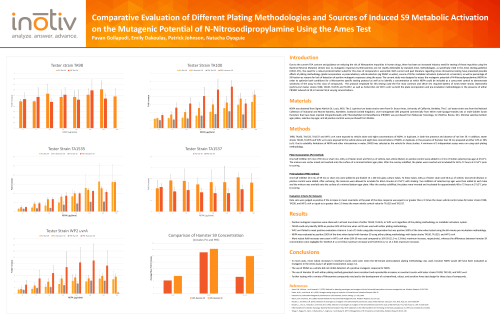Ames Assay
Inotiv provides a comprehensive offering of Ames assay designs to meet the needs of all industries

Ames Assay (Bacterial Reverse Mutation Assay) OECD 471
The Ames test (Bacterial Reverse Mutation test) provides a simple, straight-forward measure of the mutagenicity of small molecule formulations of pharmaceuticals, chemicals, cosmetics, flavors and fragrances, consumer products, veterinary products, impurities, and more. Inotiv follows the OECD 471 testing guideline for the Ames assay. The Ames test is a required test for pharmaceuticals as part of the ICH S2(R1) genetic toxicology test battery.
The Ames assay identifies point mutations caused by base substitutions or frameshift mutations by using bacterial cells that carry point mutations in genes required to synthesize the amino acid histidine or tryptophan. Inotiv typically uses Salmonella typhimurium strains TA98, TA100, TA1535, TA1537 and an Escherichia coli strain, but other strains are acceptable under the OECD 471 guideline. The core principle is simple: detection of mutations that "reverse" existing mutations in the test strains. When these mutations are reversed, the bacteria regain their ability to synthesize histidine or tryptophan, resulting in the growth of mutated bacteria that can then be quantified.
Exposure Methods: There are two different primary exposure methods in the Ames assay. The plate incorporation method combines the test article with bacteria in top agar just prior to plating, whereas the preincubation method co-incubates the test article with the bacteria before mixing with top agar and plating. While the plate incorporation method is most widely used for the Ames assay, the preincubation method is considered the more sensitive method for the detection of mutagens, especially for certain classes of chemicals.

At Inotiv, we offer a comprehensive array of methods, designs, and options for Ames tests, including:
- Ames Plate Incorporation Method
- Ames Preincubation Method
- Ames 6 Well assay
- Ames Treat and Plate Method (for compounds containing histidine or tryptophan)
- Enhanced Ames Test (EAT) for nitrosamine qualification
- Prival modification of the Ames test for azo dyes
- Ames test for volatile liquids
- Ames test for medical device biocompatibility testing per ISO 10993-3
All of our Ames assays can be performed to follow the GLP regulations or as a non-GLP test for screening purposes.
AMES Assay FAQ:
What is the Ames assay?
The Ames assay is a reverse mutation process that exposes histidine or tryptophan deficient auxotrophs to mutagens causing reversions to histidine and tryptophan proficient prototrophs (wild-type bacteria). The reversion process yields growth of revertant colonies on agar plates that are enumerated during evaluation.
What tester strains are typically used?
The standard Ames assay utilizes five strains of bacteria. Usually, four strains of Salmonella typhimurium (TA98, TA100, TA1535, and TA1537) and one strain of Escherichia coli (WP2 uvrA or WP2 uvrA (pKM101)). Salmonella tester strain TA102 can also be used in place of E.coli.
What are options for early screening?
Screening can be performed using a minimum of two Salmonella tester strains (TA98 and TA100). These two strains provide information for base-pair and frameshift mutations and have high concordance with the GLP assay. Screening can also be performed using up to all five tester strains as are used in the GLP assay. We also offer miniaturized versions of the assay performed in multi-well plates which require less test compound.
What is the next step if the Ames test is positive?
There are several options for a follow-up to a positive Ames test, including the Pig-a assay, transgenic rodent mutation, and duplex sequencing.
What is the Enhanced Ames Test (EAT)?
Regulatory agencies such as U.S. Food and Drug Administration (FDA), the European Medicines Agency (EMA), and others have provided updates to their guidance as related to testing of Nitrosamine Drug Substance-Related Impurities (NDSRIs). The Enhanced Ames Test provides test conditions that are considered optimal for determining the mutagenic potential of this class of compounds. In addition to use of specific tester strains and use of the preincubation methodology, the test conditions call for the use of both induced rat and hamster liver S9 at higher concentrations than routinely used in an Ames assay, and the inclusion of two additional N-nitrosamine positive controls. FDA EAT guidance and EU EAT guidance.
Explore other genetic toxicology assays:
| Mutation | Cytogenetic Damage | DNA Damage |
|---|---|---|
| Ames assay | In Vitro Micronucleus assay | Comet assay |
| HPRT assay | Chromosome Aberration assay | |
| Mouse Lymphoma assay | In Vivo Micronucleus assay | |
| Pig-a assay |



